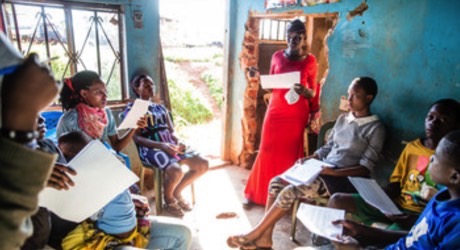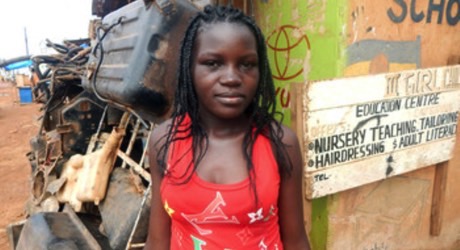The project continues to develop the capacity and agency of adolescent girls (13-18 years) and boys to promote girls’ rights, safety and inclusion in Kampala, Uganda.
Objective: Adolescent girls and boys are sensitised and supported to take action and leadership on gender inequality, sexual harassment and girls’ safety.
The project ensured adolescent girls and boys were at the forefront of implementation. They were provided platforms to speak during awareness campaigns with transit authorities; 151 (89 girls and 62 boys) were engaged and presented their asks to leaders at differing government levels.
• Girls working alongside boys aided the challenging of societal stereotypes. Boys and men have been involved and engaged to appreciate gender equality and the negative impact of maintaining an unequal gender order in the communities where they live e.g. through the Champions of Change modules which are tailored to shape the perspective of boys to understand gender, rights, violence and sexuality.
• The adolescent girls and boys engaged in Champions of Change demonstrate empowerment that is coherent with a shift in their attitudes and practices in gender equality and girls rights. They are more assertive, with confidence to talk about their issues, and the groups are used for engagement and commitment to their cause. The girl participants have continuously exhibited a sense of self-worth, confidence and self-respect while the boys are now more knowledgeable on girls’ rights and supporting them to stand for these rights.
• With two clubs in each school, there are now over 720 children members of the safety clubs in schools.
• The Champions of Change (CoC) community sessions are now attended by over 900 participants in different communities on a weekly basis.
• 16 girls, 8 boys, and 24 teachers participated in Training of Trainers (TOT) Champions of Change training to enable additional school clubs and training sessions to be established and operate into the future
• 8 girls clubs and 4 boys clubs participated in joint action planning.
• 12 clubs promote girl’s safety on National Day.
• 30 girls and 10 boys with disabilities were provided with support to establish youth associations.
Objective: Government, transport sector, parents and communities, have increased awareness on girls’ safety, and take action.
• Seven awareness sessions on safety and discrimination against girls with disabilities were conducted for parents and other community members
• Fathers’ and mothers’ safety clubs were formed by parents with an in-depth knowledge and understanding of the Safer Cities project. On a weekly basis during the parent club meetings, there are various sessions on changing attitudes towards gender stereotypes against girls, and understanding the roles and responsibilities of parents in creating safety for girls.
• Dialogues with parents: adolescent club members have been meeting with parent safety clubs to talk about safety in the area. Parents publicly express approval or defend their activities and right to take action and they also show commitment through collective action in support of girls’ safety in cities.
• Trainings on gender equality were carried out for taxi and bus operators. As a result, the men who were a part of the training have been able to change their behaviour and attitude towards their family members and adolescent girls they meet in public spaces. They are now championing the change in the transport sector.
• Equal participation was promoted in the transport industry, which is dominated by men. The Safer Cities team is working with the bus companies to recruit more young women, and lobbying is being done with taxi companies to ensure more women join their business. There has already been an increase in the number of women conductors.
• Two major public campaigns on street harassment, safety on transport; promoting coalition building were delivered.
• The first was an outside advertisement campaign. Educative messages about abuse against girls in public spaces were put on billboards and street poles. This had the purpose of getting the bus drivers, boda boda riders, taxi drivers, conductors, other operators and passengers to know about the project and to ensure they support making cities safer for girls. There has been feedback from the community that the messages are relevant and timely amidst challenges of violence of women and girls in public spaces. It was reported that sexual harassment has reduced due to the different messages published in the campaign.
• The solidarity campaign led to significant commitments from the Kampala Capital City Authority to make changes such as improving lighting and street naming, ensuring buildings meet accessibility standards, and running a public awareness campaign to change attitudes around street harassment.
As the leader of her girls safety group, Faridah has met with the local mayor to advocate on safety issues in her community, she has participated in a short video and street drama to raise awareness amongst adolescent girls about their safety, and she has participated in a televised people's parliament to promote safety and gender equality for girls. Faridah now feels more confident, she is able to speak up and express her views, and she is aware of her rights. She has returned to school and is determined to continue to be a leader in the Safer Cities program.
Faridah spoke to Plan International and said: "In my community, most of us are child mothers. Before, we never knew our rights but this program has taught us to stand up for ourselves. My family now see me as valuable, because of my goal that I want to be a champion of change in our society".
Adolescent girls as champions for gender equality and girls safety in cities
Adolescent girls in the capital city of Uganda, Kampala, are subject to street harassment and gender-based violence in their communities. The Safer Cities for Girls project has supported over 5,800 adolescent girls and 2,051 adolescent boys to champion gender equality and safety for girls in public places.
Faridah, 21, has become a 'Champion for Change' in the Safer cities for girls program and is the leader of her girls’ safety group. Faridah dropped out of school and is a single mother with two children. She used to sell nuts and chips by the roadside and worked in the evenings, from 6pm up to midnight, where she experienced harassment and robbery.
What next?
Aiding the sustainability of the project is the Safer Cities coalition, composed from different government departments and representatives from women’s organisations who can take lead through local ownership and capacity to deliver on the objectives of the program. Continuing to strengthen networks with like-minded organisations and coalitions enables us to jointly advocate for the issues of adolescent girls. The multi-sectoral networks are likely to influence policy and practice nationally and locally.
Similarly, the program has built the capacity of local community structures. The adolescent girls and boys clubs has enabled the participation and mobilization of their peers; equipping them with the skills to advocate and build a movement of girls who can demand their rights. It is expected that these efforts will be sustained after the program has ended.
Project Background
Around the world, in both low and high income countries, girls and young women feel that cities are not safe places for them to be. Girls and young women frequently feel uncomfortable, unsafe and intimidated on their city streets and in public places (including public transport).
The consequences of street harassment run deep. When girls and women are frequently made to feel afraid, to the point of avoiding public places, they are being denied the space and opportunity to work, study or play in their own cities. When they feel excluded from public spaces, they are excluded from the opportunities the city offers to everyone else.
For example, Plan International’s research shows that street harassment or abuse causes some girls drop out of education or paid work. Some avoid the city altogether, confined to their home or neighbourhood. This affects their future employment prospects and ability to lead independent lives and become active and engaged citizens.
To be groped, cat-called and abused in public is too often regarded as ‘just a normal part of being a girl’. Girls are led to believe it is their fault. Many feel that there is little point in reporting harassment, abuse or violence to the authorities, perceiving that they have neither the will nor the power to do anything about it.
The problem is widespread, 45% of girls in Kampala reported sexual harassment when using public transport.
Project Overview
The Safer Cities for Girls program goal is to build safe, accountable and inclusive cities with and for adolescent girls through increasing their safety and access to public spaces, enabling their safe mobility in the city; and increasing their active and meaningful participation in the design of urban environment.
Preventing and addressing gender-based violence and sexual harassment in public spaces and transport sectors is a key focus and the program aims to transform pervasive social and cultural norms that allow for unequal power dynamics, gender based discrimination and violence against women and girls.

By engaging adolescent girls as active agents of change, building their individual capacity and collective agency to engage with decision makers we can identify and address issues for girls’ safety and inclusion in cities like Kampala.
The program works at multiple levels: with institutions and organisation to make services and environments receptive and inclusive of girls’ safety and interests; and with families, communities, adolescent girls and boys to promote gender equality, and girls’ rights, safety and inclusion.
Key Project Strategies
- The engagement of Champions of Change – a community-wide approach to gender equality and social norm change through peer-to-peer youth engagement. This school based program includes a training curriculum for adolescent girls on gender equality and empowerment, and a curriculum for adolescent boys to challenge and transform harmful gender norms, and build a social movement for the promotion of gender equality and new models of masculinities.
- Training curriculums for transit staff to enhance their understanding of gender equality and girls’ rights and the need for safe and inclusive planning, policies and services.
- Establishment of youth clubs and safe spaces.
- Safety Walks and Community Score Card processes.
- Intergenerational interface meetings and forums for girls, boys, community members, government representatives and transport operators to share challenges and develop solutions to make cities more gender-equitable, safe and inclusive.

What's Covered in Project Cost
- 1,230 adolescent girls and 438 boys in schools and communities are engaged in Champions of Change, through curriculum, project activities and events.
- 56 teachers in 10 schools; 35 community facilitators provided with Champions of Change training.
- 400 transport workers trained and supported to increase their awareness and take action.
- 4,825 males; 6,653 female community members and parents increase awareness through project materials; public awareness campaigns; inter-generational dialogue.
Project Outcomes
- Key stakeholders (local authorities, law enforcement, schools etc.) are engaged to have increased capacity and willingness to promote girls' safety.
- Transport authorities and staff are engaged to promote and support the safety of adolescent girls.
- Increased willingness of bystanders to protect and support girls when experiencing harassment and insecurity on transport systems.
- Increased capacity of adolescent girls to take on leadership roles in their communities on girls’ safety.
- Increased awareness and engagement of adolescent boys as Champions of Change for gender equality, girl’s rights and safety.
- Girl-led initiatives on their rights to safety are supported by families, communities and authorities.
- Community managed public spaces are safe and inclusive of adolescent girls.
Part of a Larger Strategy
At present there are five cities taking part in the project including Kampala, Hanoi (funded previously by the Footprints Network), and Delhi. Our ambition is to expand the program to 20 cities by 2020.